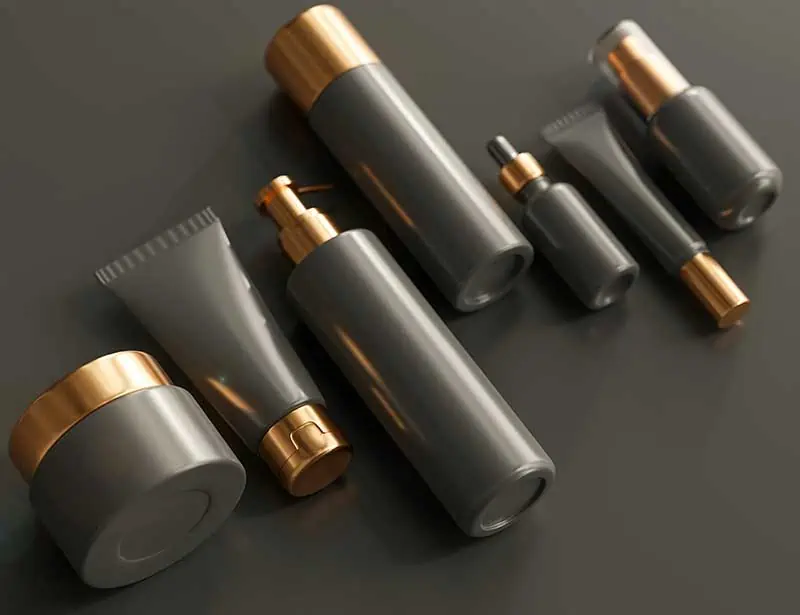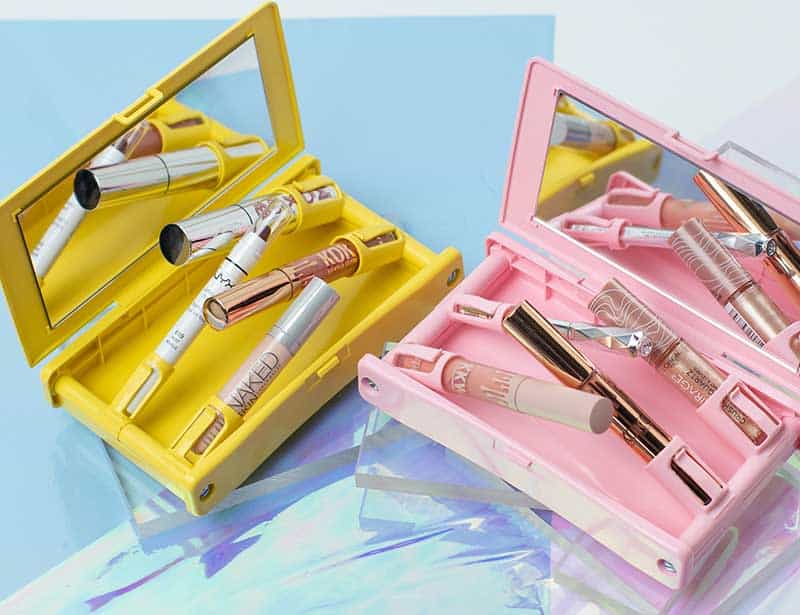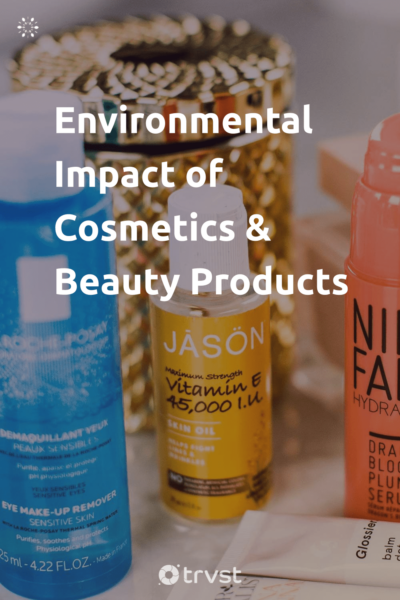Environmental Impact of Cosmetics & Beauty Products
Early human records show that we have always found ways to beautify ourselves. But as innovation happened, people gradually moved from natural materials to processed, packaged materials. But what are the costs of our creativity and innovations with cosmetics and beauty products? And therefore, what is the environmental impact of cosmetics?
In this article, we take a deep dive into the beauty industry to examine the impact of cosmetics on our environment.
Beauty industry environmental impact
The Food and Drug Administration (FDA) categorizes materials applied to the human body for cleansing, beautifying, promoting attractiveness, or altering the appearance without affecting the body's structure or functions as cosmetics. Perfumes, moisturizers, nail polish, makeup, hair products, and even toothpaste fall under this category.
The 2020 British Beauty Council report suggested that the beauty industry had an essential role to play in the urgent change required to deal with climate change. Below are some reasons why.
The packaging menace

Packaging in the beauty industry is less practical and more fanciful. Beauty brands seem to go all out for packaging. Often the more expensive or luxurious a product is, the more nonessential packaging you may expect to find. About 70% of the beauty industry’s waste comes from packaging6.
According to the latest reports from Zero Waste Week, beauty packaging amounts to 120 billion units every year. That includes plastic, paper, glass, and metals, all of which end up in landfills year after year.
Recycling is not always straightforward with cosmetic packaging because brands make most boxes, bags, and containers with mixed materials. Even when the components are separable, it is usually a waste of time for recycling workers. Although consumers can help by separating the pieces themselves, it is not convenient. 56% of British people do not recycle shampoo or shower gel bottles because it is stressful to do so.
Plastic pollution
About 8 million tonnes of plastic enter the ocean each year, and cosmetic containers inevitably contribute in no small measure. Some of these plastics wash ashore and become an eyesore, but plastic pollution has more devastating consequences.
Plastic waste is a severe environmental issue. On land and in water bodies, plastic waste is both an eyesore and a pollutant. Plastic is not biodegradable, which means that it will not decompose. However, it goes through a process called photodegradation which breaks it down into microscopic sizes. This process takes between 100 to 500 years to complete, depending on the type of plastic. The UN environmental program has warned that if the waste trend continues, there will be more plastic in the oceans than fish by 2050.
Related: 38 Plastic pollution facts further illustrate how our overreliance on single-use and disposable plastic impacts our environment. Also, read up on our deeper dive into the impact of plastic water bottles on the environment.
Millions of birds and fish die from the complications of plastic being in and around the sea. From entanglement to blockage of the digestive tract, plastic bits and pieces slowly and painfully kill sea life. Large land animals have also died from eating plastic.
Scientists have confirmed that ingesting microplastic can cause specific genetic mutations and changes in fish behaviors1.
Plastic pollution is not only affecting marine life. Humans are at risk too. Researchers have discovered plastic microfibers have to be airborne and found in tap water. Furthermore, they have discovered microplastics in over 100 aquatic species consumed by humans4.
Microbeads
Plastic pollution originating from beauty products does not end with plastic packaging. Even the products themselves contain plastic which we call microbeads. We usually find plastic microbeads in body scrubs and other beauty products as exfoliants. They are tiny plastic particles no bigger than 5mm.
When you use a product containing microbeads, you send countless microplastics down the drain into water bodies. There they attract toxins and are swallowed by fish and, eventually humans.
The world’s oceans already suffer from catastrophic plastic pollution, and microbeads only make matters worse. Although the US and UK have banned the production of microbeads since 2015 and 2018, respectively, you may still find them present in some products. Cosmetic manufacturers that operate in countries with no microbead regulations have nothing to stop them from using harmful plastic.
Unsustainable resource consumption

Beauty products with natural ingredients are not necessarily better than chemical-based products if the raw material production is unsustainable.
Palm oil is one of the most used beauty product ingredients, popular both for its effects on the body and the planet. The high demand for palm oil has led to unsustainable extensive cultivation. Palm oil plantation encroachment has destroyed natural forests, and countless animal species have lost their natural habitats. Other cosmetics industry oil sources like soy, rapeseed, and coconut perform no better than palm oil when not sustainably cultivated as well.
The beauty industry’s unsustainable consumption is not exclusive to natural resources. Non-renewable natural resources like fossil fuels and metals are also affected. Single-use items also contribute to waste in the beauty industry. We often use items like wet wipes, sheet masks, and blotting sheets only once before trashing them. When we compare the process and costs to the ecosystem, single-use items are not such a great idea for sustainable living.
Ocean chemical pollution
From our bathrooms to spending hot summer days at the beach, toxic chemicals in beauty products leach into the oceans from our bodies. Shampoos, sunscreens, creams, and lotions sometimes contain chemicals harmful to humans and wildlife when they get into the environment.
Parabens and triclosan are chemicals found in a variety of cosmetic products acting as preservatives. For example, some sunscreen products contain benzophenone or its derivative oxybenzone.
These chemicals have been tagged as endocrine disruptors and linked with cancer2. Fourteen thousand tons of sunscreen get into the ocean and settle on coral reefs every year. Oxybenzone is a culprit in the massive destruction of coral reefs in the world's oceans.
Chemical ingredients like BHT, sodium Laureth sulfate, and BHA have been found to cause changes to the biochemistry of aquatic life. They reduce the animal plankton population, and sometimes these toxic chemicals result in fish death.
Even after sewage treatment, some of these chemicals remain in our water supply.
Air pollution
Volatile organic compounds (VOCs)5 are air pollutants found in cleaning agents, printing inks, pesticides, and wood finishings. It is also present in some beauty products like perfumes, deodorants, and hair sprays. A recent study has revealed that these products are significantly contributing to carbon dioxide emissions3. The study showed that household and beauty product emissions contribute to half of the VOCs emitted in 33 urban cities.
Let's not forget the carbon footprint of the myriad of fossil fuel-derived materials used in beauty products and packaging throughout the global cosmetics industry. Even with natural ingredients extracted and processed in unsustainable ways, carbon pollution is a significant concern.
Animal cruelty
Testing cosmetics on animals could be inhumane and unnecessary. Cruelty-Free International argues animal experiments are ineffective since they do not even get many human diseases. Scientists artificially introduce these diseases in a laboratory setting that does not necessarily mimic the real-life situations of humans.
There have been decades of studies highlighting where lab animals recovered from incurable human diseases. However, the cure may still not work on humans. 90% of drugs do not work on humans even after successful animal testing.
The Chinese government used to require animal testing for cosmetics but has largely now relaxed this policy. As of 2021, China still requires animal testing for imported 'special use' cosmetics like sunscreens and hair dyes. Beauty companies in the US are not obligated to conduct animal tests by any government policy. However, there are insufficient regulations to prevent a company from testing products on animals.
An example of animal testing is the skin and eye irritation tests, where animals have their eyes and shaved skin exposed to chemicals. Of course, they don’t administer pain relief while the animals suffer in restraints. Another cruel test is the lethal dose test, where researchers inject animals with a lethal dosage of chemicals to single out fatally toxic chemicals.
Testing facilities usually put down animals that do not die from the rigors of lab tests through asphyxiation, neck-breaking, or decapitation. In the United States, a large percentage of lab animals do not enjoy any protection under the Animal Welfare Act.
Deforestation
To make way for plantations that provide an abundance of plant-based raw materials for the beauty industry, producers have cleared extensive areas of natural forests. They also cut trees to make tons of cardboard boxes, paper wraps, and packing tissues that consumers throw away as soon as they begin using the product.
Packaging from tree-based products consumes 18 million acres of forest every year. Such large-scale industrial deforestation has contributed significantly to global warming. Trees are carbon sequesters, and cutting them down releases co2 back into the atmosphere.
Rapid deforestation not only contributes to climate change but also affects biodiversity negatively. Native plants and wildlife populations are dwindling. The World Wildlife Foundation reports that the wildlife population has decreased by 68% since 1970. Sadly, the trend continues even today.
Child labor
Mica is a natural silicate mineral dust used to brighten and add shine to makeup products. They mine this valuable mineral in India. This natural material has been a source of controversy as advocates of fair labor have implicated the mica mining industry in child labor practices7.
Mining is dangerous, especially for children. Exposure to mineral dust can cause respiratory illnesses. Also, its illegal nature of it prevents safety structures from being provided. The mines frequently collapse, and children can sustain serious injuries or die. Child miners face an average fatality rate of 32 per 100,000.
This violates the international labor conventions 182 on the minimum age for admission to employment and 138 on the worst forms of child labor. A 2016 research study estimated the number of children involved in mica mining in Jharkhand and Bihar at 22,000. Subsequent field research also showed that most companies could certify they did not involve child labor in the mica used in their end products.
Read more: What Is Mica Powder? Uses, Safety, And More.
What you can do
Many issues plague the cosmetic industry, from waste to overconsumption and farming practices that harm the ecosystem. However, all is not lost, as beauty brands are taking notice of the fact that consumers are veering toward sustainability. Therefore, some brands are taking steps to be more ethical, transparent, and environmentally safe.
While the beauty industry is trying to become more sustainable, you can do a few things to help push the agenda of sustainable cosmetics forward.
Choose natural beauty products

Beauty products with natural and organic ingredients are not only good for your skin, but they are also good for the environment as well. Cosmetics with toxic ingredients can cause irreparable damage to your skin, health, and the environment.
From bath products to, deodorants, make-up, and sunscreens, there are so many cosmetics made with natural ingredients and minimal to low-zero-waste packaging available. These products are not hard to find either; check out some of our lists of the best here:
- Zero-waste makeup
- Zero-waste deodorant
- Zero-waste sunscreen
- Zero-waste mascara
- Zero-waste makeup remover
Buy from sustainable beauty brands
There are so many beauty companies with tons of beauty products in the market today, and more are still cropping up every day. Look out for the brands that operate on sustainable practices like using renewable energy sources, minimalist or recycled paper packaging, and sustainable palm oil. Apart from zero negative impact on the environment, fair labor and trading practices are also important.
Finding the one that beautifies your skin without destroying the planet may not be as easy as just picking the nicest-looking product on the shelf, but it is well worth every effort that goes into it.
Educate yourself
Some big beauty brands tout themselves as natural or organic while being only partially or insignificantly so. The British Beauty Council reports showed that 1 in every 3 persons does not understand the origin or impacts of the ingredients in their beauty brand choices or personal care products.
Greenwashing tricks many consumers into buying cosmetics with too many harmful chemicals and too few natural ingredients. Many brands are guilty of greenwashing their products. They may add just 1% organic material and proceed to label the product ‘green,’ ‘natural,’ or ‘organic.’
Learn about the ingredients and certifications that indicate how safe a product is for you and the environment. Don't forget to help raise awareness by telling friends and family about the things you learn.
Conclusion
We should care for our beautiful planet as much as we care for our cherished bodies. Personal care products that cause environmental damage do not reflect true beauty. Adjust your beauty routine to fit into your sustainable lifestyle.
| 1 | Limonta, G., Mancia, A., Benkhalqui, A. et al. Microplastics induce transcriptional changes, immune response and behavioral alterations in adult zebrafish. Sci Rep 9, 15775 (2019). https://doi.org/10.1038/s41598-019-52292-5 |
| 2 | Juliano C, Magrini GA. Cosmetic Ingredients as Emerging Pollutants of Environmental and Health Concern. A Mini-Review. Cosmetics. 2017; 4(2):11. https://doi.org/10.3390/cosmetics4020011 |
| 3 | Brian McDonal et al. (2018) Volatile chemical products emerging as largest petrochemical source of urban organic emissions. Science vol 359, issue 6377, pages 760-764. |
| 4 | Issac, M.N., Kandasubramanian, B. Effect of microplastics in water and aquatic systems. Environ Sci Pollut Res 28, 19544–19562 (2021). https://doi.org/10.1007/s11356-021-13184-2 |
| 5 | United States Environmental Protection Agency, EPA (2021) Volatile Organic Compounds’ Impact on Indoor Air Quality EPA.gov. |
| 6 | The courage to change (Pdf, 2020) British Beauty Council |
| 7 | Global mica mining and the impact on children's rights (2018) SOMO |
Jen’s a passionate environmentalist and sustainability expert. With a science degree from Babcock University Jen loves applying her research skills to craft editorial that connects with our global changemaker and readership audiences centered around topics including zero waste, sustainability, climate change, and biodiversity.
Elsewhere Jen’s interests include the role that future technology and data have in helping us solve some of the planet’s biggest challenges.

